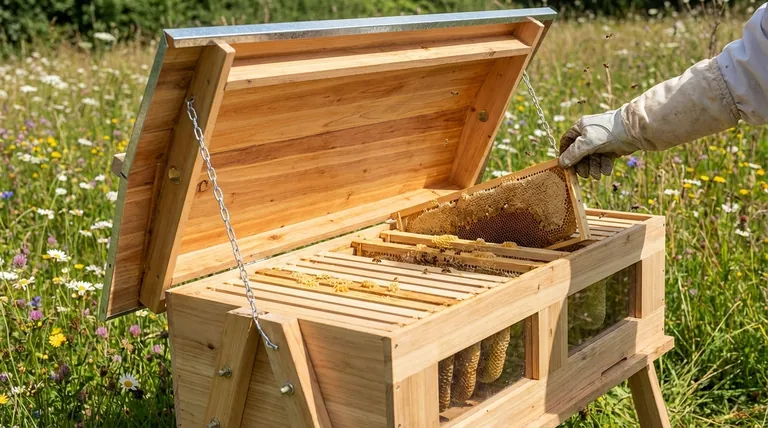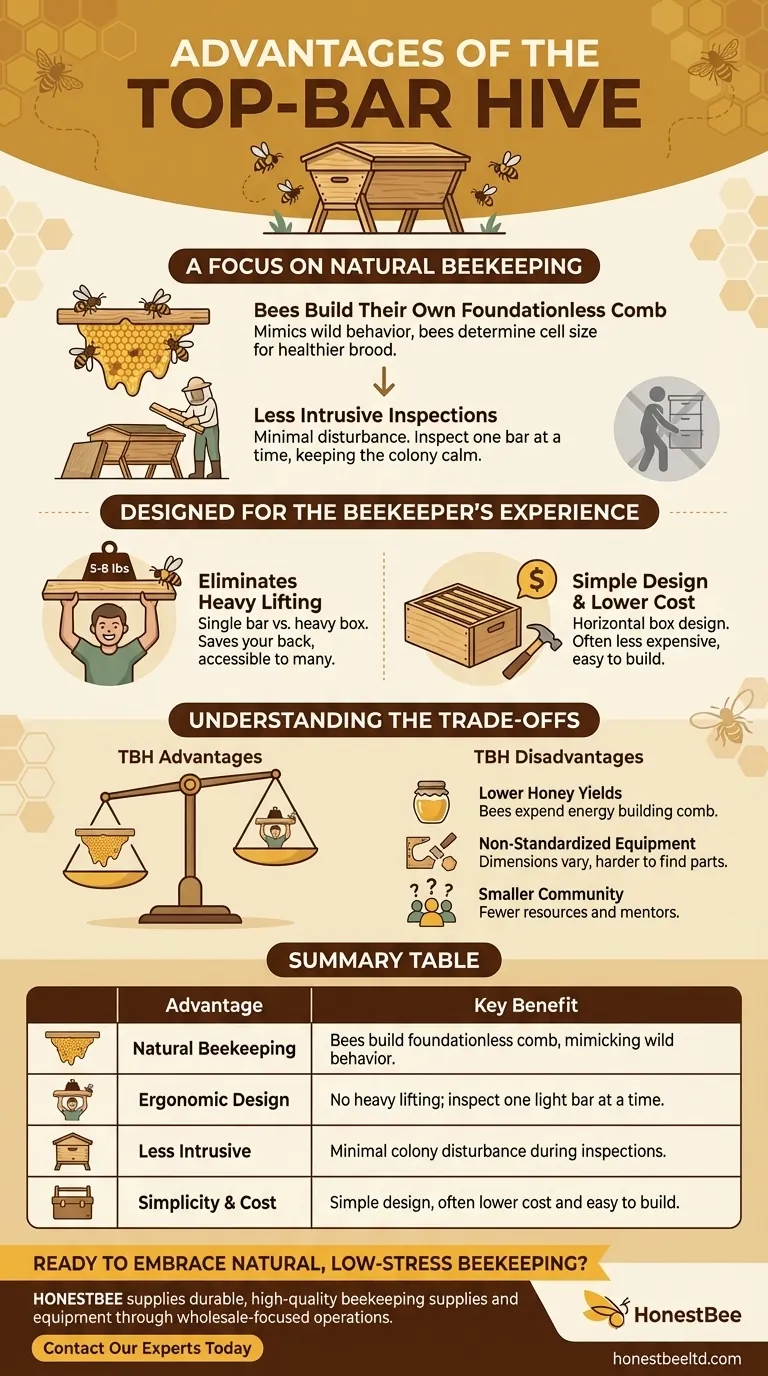The primary advantages of the Top-Bar Hive are that it facilitates a more natural style of beekeeping, is significantly easier on the beekeeper's body, and allows for less disruptive colony inspections. Because bees build their own comb from scratch and the beekeeper only lifts one comb at a time, this hive design is often favored for its simplicity and bee-centric approach.
Choosing a hive is less about which is "best" and more about aligning the equipment with your personal goals. The Top-Bar Hive excels for beekeepers who prioritize the well-being and natural behavior of bees over maximizing honey production.

A Focus on Natural Beekeeping
A core appeal of the Top-Bar Hive (TBH) is its alignment with treatment-free or "natural" beekeeping philosophies. The design inherently encourages bee behavior that more closely mimics how they live in the wild.
Bees Build Their Own Foundationless Comb
In a TBH, bees build their comb down from a simple wooden bar, without the pre-stamped wax or plastic "foundation" used in other hives. This natural comb construction is a key advantage.
This allows bees to determine the cell size they need, which is essential for raising brood (young bees) and storing resources. Many believe this autonomy contributes to a healthier, more resilient colony.
Less Intrusive Inspections
Inspecting a TBH causes minimal disturbance to the colony. You inspect the hive one bar at a time, leaving the vast majority of the colony undisturbed and covered.
This contrasts sharply with standard Langstroth hives, where you must lift and separate entire heavy boxes, exposing the whole colony to light and air. The result in a TBH is calmer bees and a less stressful experience for both the beekeeper and the hive.
Designed for the Beekeeper's Experience
Beyond its bee-centric nature, the Top-Bar Hive is profoundly practical, especially for those concerned with the physical demands of beekeeping.
Eliminates Heavy Lifting
This is arguably the most significant ergonomic advantage. A single top bar full of honey, brood, and wax might weigh 5-8 pounds.
In contrast, a standard Langstroth honey "super" (box) can easily weigh 50-80 pounds. The TBH design, which never requires you to lift more than one bar, saves your back and makes the hobby accessible to a much wider range of people.
Simple Design and Lower Cost
The Top-Bar Hive is essentially a long, horizontal box with a lid and wooden bars across the top. This simple design means they are often less expensive to purchase and relatively easy to build yourself from plans.
This lower barrier to entry makes it an attractive option for new beekeepers who want to start without a significant financial investment in standardized, manufactured equipment.
Understanding the Trade-offs
No hive design is perfect for every situation. To make an informed decision, you must weigh the advantages of the TBH against its distinct disadvantages compared to the industry-standard Langstroth hive.
Lower Honey Yields
Because bees must draw out all their comb from scratch, they expend significant energy that could otherwise be used for foraging. Consequently, TBHs are not favored for commercial-scale honey production.
The Langstroth hive, with its reusable foundation and efficient vertical space, is designed specifically to maximize honey surpluses.
Non-Standardized Equipment
While Langstroth parts are standardized and interchangeable between manufacturers, Top-Bar Hives are not. The dimensions can vary, meaning parts from one hive may not fit another.
This lack of standardization makes it more difficult to find and purchase replacement parts or accessories.
A Smaller Community of Users
The Langstroth is the most common hive type in the world. This means there is a vast amount of readily available information, mentorship, and support from other beekeepers.
While the TBH community is passionate and growing, it is smaller. Finding an experienced local mentor or specific advice can sometimes be more challenging.
Making the Right Choice for Your Goals
Your selection should be a deliberate choice based on your philosophy and physical capabilities.
- If your primary focus is a natural, low-stress experience for both you and the bees: The Top-Bar Hive is an excellent choice that removes heavy lifting and encourages natural bee behavior.
- If your primary focus is maximizing honey production and using industry-standard equipment: The Langstroth hive is the more conventional and better-supported path for achieving high yields.
Understanding these core differences empowers you to select the hive that best fits your personal beekeeping journey.
Summary Table:
| Advantage | Key Benefit |
|---|---|
| Natural Beekeeping | Bees build foundationless comb, mimicking wild behavior. |
| Ergonomic Design | No heavy lifting; inspect one light bar at a time. |
| Less Intrusive | Minimal colony disturbance during inspections. |
| Simplicity & Cost | Simple design, often lower cost and easy to build. |
Ready to embrace a natural, low-stress beekeeping method?
For commercial apiaries and distributors, the right equipment is the foundation of a successful operation. HONESTBEE supplies durable, high-quality beekeeping supplies and equipment through wholesale-focused operations, helping you build and manage your hives efficiently.
Contact our experts today to discuss how our wholesale solutions can support your beekeeping goals with the Top-Bar Hive or other essential equipment.
Visual Guide

Related Products
- Long Langstroth Style Horizontal Top Bar Hive for Wholesale
- HONESTBEE Professional Long Handled Hive Tool with Precision Cutting Blade
- HONESTBEE Professional Multi-Functional Hive Tool with Ergonomic Wood Handle
- HONESTBEE Advanced Ergonomic Stainless Steel Hive Tool for Beekeeping
- Top Bar Beehive for Beekeeping Wholesales Kenya Top Bar Hive
People Also Ask
- How does the design of a top bar hive benefit beekeepers? Ergonomic & Natural Beekeeping for Hobbyists
- What are the benefits of a top bar hive? A Natural, Low-Impact Approach to Beekeeping
- How does the top bar hive help control varroa mites? A Natural Approach to Mite Management
- What are the benefits of the top bar hive? A Guide to Ergonomic, Natural Beekeeping
- What are the box management requirements for a top bar hive vs. Langstroth? Choose Your Hive Strategy



















